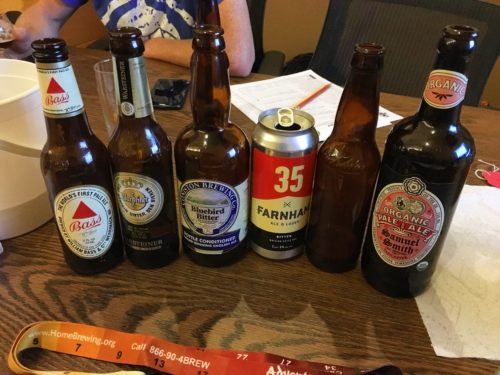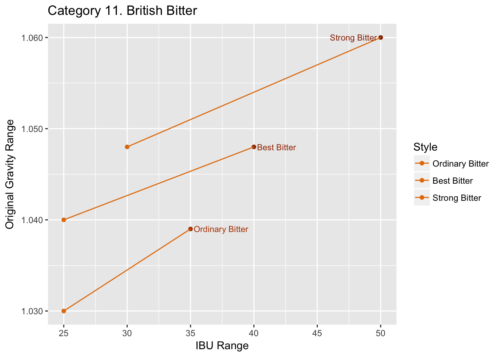BJCP Study Group: Category 11
¶ by Rob FrieselAfter the whirlwind that was last time, study group session #7 covered a single and (allegedly) stylistically narrow category: the British Bitters.
Though we did not have a guest judge, we had a good selection of representative beers, 1 of both the commercial and homebrew stripes.
Category 11: British Bitter
Not to be too reductionist about it, but the 3 styles in this category are basically the same, with the key differences lying with the gradations of bitterness and ABV. In all cases, low levels of diacetyl are acceptable, but not required or expected. Bitterness should be a defining characteristic, but not out of balance (i.e., they’re not IPAs). 2 Malt profiles should be biscuity or nutty or bready, and have some sweetness from a restrained touch of caramel or crystal malts. Hop aromas are earthy or resiny or floral; it isn’t that they must be traditional British hops 3 but using American hops must be done with restraint! Fruity ester qualities are expected in the Category 11 beers. Medium body in the mouthfeel (or somewhere close on either side) with relatively low carbonation. The stronger 11C beers may have some pronounced alcohol, provided that doesn’t knock it out of balance. Balance is key! Drinkability is key!
All things being (otherwise) equal with respect to that flavor profile, here’s how the vital stats break down:
| 11A. Ordinary Bitter | 11B. Best Bitter | 11C. Strong Bitter |
|---|---|---|
| 25 – 35 IBU | 25 – 40 IBU | 30 – 50 IBU |
| 1.030 – 1.039 O.G. | 1.040 – 1.048 O.G. | 1.048 – 1.060 O.G. |
| 1.007 – 1.011 F.G. | 1.008 – 1.012 F.G. | 1.010 – 1.016 F.G. |
| 3.2 – 3.8% ABV | 3.8 – 4.6% ABV | 4.6 – 6.2% ABV |
We decided to take a slightly different tack for this study session. We had a catch-up/warm-up beer from a previous session, and from there we would work through our categories. Because we had multiple examples for each style in the category (except for 11A!), we decided to a structured evaluation for one and then do an unstructured tasting for another as a side-by-side comparison.
- 5A. German Leichtbier. Warsteiner Premium Verum. Unstructured tasting — once we realized it was probably more of a 5D than a 5A. We had a hard time determining the age, but it seemed pretty oxidized and papery-tasting. The nose was on the floral side and had light bread on the palate.
- 11B. Best Bitter. Conniston Bluebird Bitter. Structured tasting. The consensus at the table was that more bitterness in the balance would have helped the score. Several of us picked up a sweet, corny flavor — especially at the front of the mouth; that said, there was no “corn” on the nose. We debated whether this was from DMS or not. Scores were mostly in the low- to mid-30s.
- 11B. Best Bitter. (continued) Farnham 35. Unstructured tasting. We debated whether this was an 11B or 11C. The bitterness level was square in the middle of the overlapping range; at 5%, the ABV makes it 11C. Regardless of the specific style, we talked through the flaws. It missed on clarity. It was too grainy, and the finish was too harsh. The malt profile was close but lacked complexity. But hey — no evidence of oxidation?
- 11C. Strong Bitter. Bass Ale. Structured tasting. We had a lengthy discussion on the role of drinkability in scoring. What does it mean for a beer to be drinkable? How much weight do you give to drinkability over other aspects of the style’s factors? (Short answers: drinkability roughly corresponds with how much you like it, with how easy it would be to drink another; and drinkability should carry a lot of weight.) We talked about the cherry-like flavor of the esters. Some disagreed, called it toffee flavors from the malt. (But the open questions: who perceived what first? were both present? was one stronger? or was this a matter of personal perceptual sensitivity?)
- 11C. Strong Bitter. (continued) Samuel Smith’s Organic Pale Ale. Unstructured tasting. A sweet note, almost like candy. Metallic flavors; “tinny” vs. “coppery”? Esters; “prunes” vs. “figs”?
- 11C. Strong Bitter. (continued) Queen City Landlady. Unstructured tasting. Lengthy discussion about “metallic” odors. Turned into a question of “metallic” vs. “mineral”? Side bar about yeast choices (e.g., Wyeast 1469) and which strains might enhance that minerally character. But that leads us into being reminded that you won’t know how a given beer was made, and how you can’t assume — and how you need to work from your perceptions.
- 11C. Strong Bitter. (continued) A Strong Bitter that was left over from the 2017 Noonan Competition. Unstructured tasting. Too sweet; not bitter enough in the balance. Side bar discussion about when styles have “room for interpretation”.
- 11B. Best Bitter. Aaron’s “ESB” that he had accidentally aged for two years.
- Bonus beers. A “mutt” barrel-aged beer. A 10 days grains-to-glass lupulin powder IPA experiment. A “was undrinkable” coffee imperial stout. An “experimental” amber ale that was… looking for feedback and a home category.
Takeaways
The themes and broad observations from the night:
- Metallic off-flavors? These came up a few times. We tried to get these off-flavors figured out. “Sanitation” doesn’t seem like enough of an explanation for commercial beers. So what else can explain this?
- No fore-knowledge! Remember: you can’t know and won’t know how a beer was made — so all you have to work with is your perceptions. Use your experience! But that’s also where you’ll have gaps.
- “Drinkability” and intangibles. You can have “appropriate” flavors but… Intensity matters! Complexity matters! But just how much do those factors matter? If something can have “low malt aromas” (and then does) but then doesn’t come together into a cohesive whole — what then? (Going back 2 sessions to Tyler’s advice: “Trust yourself.”)
- Excepting 11A. Ordinary Bitter. Which is apparently pretty hard to come by in these parts.[↩]
- Aside: and/but/so on that note, while beers in this category will be bitter, they won’t be as bitter as Category 18 beers, so watch out for that.[↩]
- East Kent Goldings: looking at you![↩]
About Rob Friesel
Software engineer by day. Science fiction writer by night. Weekend homebrewer, beer educator at Black Flannel, and Certified Cicerone. Author of The PhantomJS Cookbook and a short story in Please Do Not Remove. View all posts by Rob Friesel →4 Responses to BJCP Study Group: Category 11
Pingback: BJCP Study Group: Categories 18 & 21 | found drama
Pingback: BJCP Study Group: Category 19 (and/or Russian Imperial Stouts) | found drama


Leave a Reply